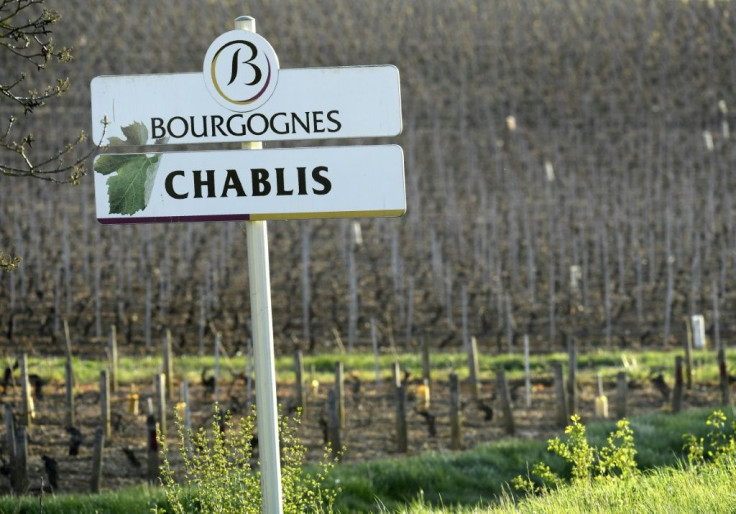No Chablis? Burgundy Winemakers Up In Arms Over Proposed Shake-up

Few French wine regions are as protective of their heritage and reputation as Burgundy, so officials should have expected the storm of protests over a plan to expel the acclaimed dry whites of Chablis from the domain.
Adding insult to injury, growers and local officials say, is a move to keep allowing the Burgundy label for some Beaujolais -- whose Nouveau reds are synonymous with underwhelming, low-cost tipples.
"It's totally unacceptable," said Thiebault Huber, president of the Burgundy federation of AOCs -- the wine appellations governed by France's National Institute of Origin and Quality (INAO).
"We don't understand how you can exclude producers who have been part of Burgundy for centuries," he said.
An AOC or Protected Designation of Origin is a certification granted to wines, cheeses and other agricultural products from a specific "terroir", or mix of geography and growing conditions said to ensure a distinctive taste.
Burgundy wine has its own AOC, which encompasses dozens of smaller AOCs, including Chablis. Each grower in the region can choose Burgundy or Chablis as their AOC for marketing purposes.
And that is part of the problem. The INAO has not yet detailed all the criteria for the proposed changes, but says most Chablis houses have effectively given up the Burgundy AOC by failing to use it for years.
Instead they prefer to play up the cachet attached to their own AOC of 100 percent Chardonnay wines.
An appellation "is linked to the environment, but also to common practices and uses", the INAO's head of territorial demarcations, Gilles Flutet, told AFP.
The proposal would also see communes in the nearby Dijon and Cote-d'Or regions prohibited from using the Burgundy AOC, potentially depriving them of a crucial marketing tool.
Growers will stage a protest at the INAO's headquarters outside Paris on Thursday, when the body was to decide on ratifying the proposed changes.
But the issue was pulled from the meeting's agenda at the last minute because of a rift "between the proposals on the table and the positions of the Burgundy winemakers' unions", an INAO spokeswoman told AFP late Wednesday.
Critics say cutting a wine region's link with its AOC opens the door to other unpredictable changes, jeopardising years of investments by producers.
"By this logic, the INAO could also decide that Cremant de Bourgogne (a sparkling wine) is a Champagne, or that a Luberon is a Cotes du Rhone," Damien Leclerc, head of the Chablis growers' association, told the daily Le Figaro, referring to other staunchly defended AOCs.
Some 31 million bottles of Chablis, valued at more than 240 million euros ($265 million), are produced each year, with two-thirds sold outside France.
At a time of further US tariff threats on French wines, Brexit uncertainties and climate change, Leclerc complained: "This is when they decide to try to exclude us, while promoting Beaujolais."
The plan would indeed allow some 40 Beaujolais communes, just south of the historic Burgundy region and sharing many of the same soil traits, to market their wines as Burgundy.
Rival houses warn their livelihoods are at risk, accusing high-volume Beaujolais producers of wanting to flood the market with lower-quality bottles that will cheapen the Burgundy brand.
"Burgundy wines are under very serious threat," a group of 12 local MPs and senators said, urging Agriculture Minister Didier Guillaume, who oversees the INAO, to reject "a crime against history, geography and the economy".
The agency's proposal is an especially bitter blow because it was the traditional Burgundy houses that had asked it to clarify its rules in the first place, to settle geographical disputes going back to the AOC's creation in 1937.
The most recent attempt at codifying the rules was rejected by France's State Council in 2014 -- after Beaujolais producers claimed they were being discriminated against.
Flutet, the INAO executive, said "nothing is set in stone", adding that "all complaints will be taken into account" before any changes are ratified.
He insisted, however, that "very few" communes facing exclusion ever use the Burgundy label, preferring the renown of their specific AOCs.
But Dominique Piron, head of the Beaujolais council, argues that his vineyards, just a little south of the Burgundy AOC border along the Saone river, boast much of the same "terroir" and history as their neighbours.
"Growers in Beaujolais make Beaujolais as well as Bourgogne and Cremant de Bourgogne, it's a reality that needs to be recognised," he told AFP.
"Today the Burgundy name is valued all over the world."
© Copyright AFP 2024. All rights reserved.





















